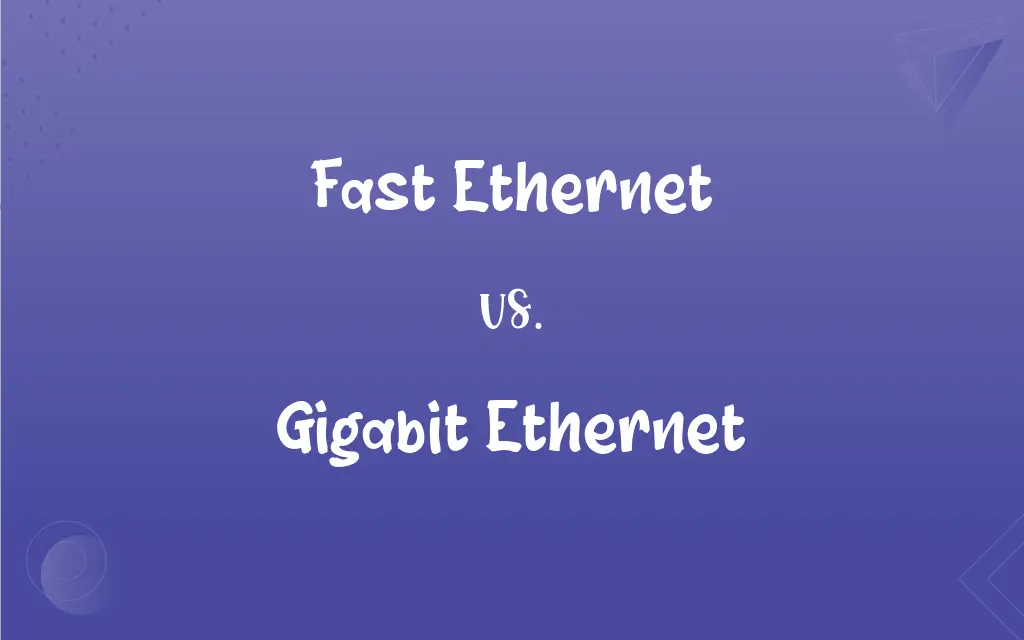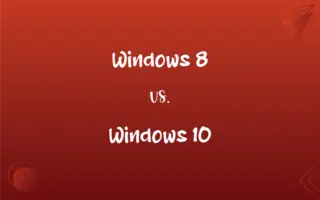Fast Ethernet vs. Gigabit Ethernet: What's the Difference?
Edited by Janet White || By Harlon Moss || Updated on October 6, 2023
Fast Ethernet offers network transmission speeds up to 100 Mbps, while Gigabit Ethernet provides significantly higher speeds, up to 1,000 Mbps (1 Gbps).

Key Differences
Fast Ethernet emerged as a pivotal progression from the traditional 10 Mbps Ethernet by propelling the data transmission speed up to 100 Mbps. Conversely, Gigabit Ethernet surged forward, elevating the transmission capability to 1 Gbps (1000 Mbps), introducing a tenfold advancement compared to Fast Ethernet, thereby fostering a more rapid data communication.
In the context of network backbone and infrastructural development, Fast Ethernet was celebrated for ensuring a seamless and efficient network flow, significantly enhancing the capabilities of its predecessor, 10Base-T Ethernet. Gigabit Ethernet, nevertheless, delivered a transformative impact on network backbones by furnishing them with a potent bandwidth that could sustain the burgeoning demand for data transmission in more complex and data-intensive networks.
Fast Ethernet, whilst being substantially faster than its forerunners, finds its place predominantly in scenarios where moderate data transmission speeds are requisite, efficiently supporting smaller-scale networks or segments. In contrast, Gigabit Ethernet predominantly forms the backbone for large-scale, enterprise-level networks due to its capability to seamlessly handle voluminous data and provide superior, unobstructed connectivity.
In practical deployment, Fast Ethernet often suffices for small business applications, residential connections, and less data-intensive environments, due to its balance of speed and economic viability. In stark contrast, Gigabit Ethernet has become quasi-ubiquitous in contemporary networking environments – residential, commercial, and industrial – to accommodate the escalating requirements of modern applications, streaming services, and data management platforms, among others.
While Fast Ethernet efficiently caters to environments with modest bandwidth requirements, Gigabit Ethernet has established itself as a norm in modern networking by abetting an environment where high-speed data transmission, bulk data movement, and simultaneous handling of multiple data-intensive tasks can be executed without compromising the network’s performance or stability.
ADVERTISEMENT
Comparison Chart
Basis of Difference
Fast Ethernet
Gigabit Ethernet
Speed
100 Mbps
1 Gbps (1000 Mbps)
Bandwidth Capacity
Moderate
High
Typical Use Case
Smaller networks, moderate data usage
Larger networks, high data usage
Standard
IEEE 802.3u
IEEE 802.3-2008
ADVERTISEMENT
Common Cable Types
Cat5, Cat5e
Cat5e, Cat6, Cat6a
Fast Ethernet and Gigabit Ethernet Definitions
Fast Ethernet
A networking standard that supports data transfer rates up to 100 Mbps.
The small business efficiently ran its operations with Fast Ethernet.
Gigabit Ethernet
A high-capacity Ethernet standard that significantly enhances network data transfer speeds.
With Gigabit Ethernet, the university could sustain the heavy data requirements of various research projects.
Fast Ethernet
A networking approach that harmoniously balances decent data transmission speed and cost-effectiveness.
For the startup, Fast Ethernet provided a cost-effective solution without compromising too much on speed.
Gigabit Ethernet
An Ethernet technology that utilizes more advanced cabling to support its high-speed data transmission.
Implementing Gigabit Ethernet, the company ensured robust and unhindered network performance.
Fast Ethernet
A network technology that provides a data rate significantly higher than its predecessor, 10Base-T Ethernet.
Fast Ethernet became a stepping stone from the previously standard 10 Mbps Ethernet.
Gigabit Ethernet
A technological evolution that successfully addressed the modern-day demand for more substantial data bandwidth and speed in networking.
The transition to Gigabit Ethernet facilitated improved productivity and data accessibility for the remote workforce.
Fast Ethernet
An elevated version of traditional Ethernet that enhances data transmission speeds.
Fast Ethernet facilitated the school's network, providing sufficient online access.
Gigabit Ethernet
A version of Ethernet technology that enables data transmission at 1 Gbps.
Gigabit Ethernet became integral for the data center due to its high-speed data transmission capability.
Fast Ethernet
A type of Ethernet that employs various forms of transmission mediums, including twisted pair cables and fiber optics.
The organization implemented Fast Ethernet using twisted pair cables for their local network.
Gigabit Ethernet
An advanced network technology designed to cater to burgeoning data transmission needs.
Gigabit Ethernet enabled seamless streaming and gaming for the internet cafe.
FAQs
What are typical applications for Fast Ethernet in modern networking?
Fast Ethernet is often used in smaller networks, such as home networks or small businesses, where high data transfer rates may not be crucial.
In which scenarios is Gigabit Ethernet preferable over Fast Ethernet?
Gigabit Ethernet is preferable in data-intensive scenarios like large-scale businesses, data centers, and high-traffic networks due to its higher bandwidth.
How do cable requirements differ between Fast Ethernet and Gigabit Ethernet?
While both can utilize Cat5e cabling, Gigabit Ethernet often benefits from higher-grade cables like Cat6 or Cat6a to maximize performance, especially over longer distances.
How do Fast Ethernet and Gigabit Ethernet impact VoIP applications?
While Fast Ethernet may suffice for smaller VoIP setups, Gigabit Ethernet offers more bandwidth and is beneficial for handling numerous simultaneous calls or larger VoIP deployments.
Is there a significant cost disparity between implementing Fast Ethernet and Gigabit Ethernet?
Generally, implementing Gigabit Ethernet can be more expensive due to higher-grade hardware and cabling, but prices have decreased as the technology has become more prevalent.
How do Fast Ethernet and Gigabit Ethernet cater to video streaming requirements?
While Fast Ethernet may support standard streaming needs, Gigabit Ethernet provides the enhanced bandwidth necessary for high-definition, uninterrupted, and concurrent video streaming.
Which Ethernet type is more future-proof: Fast Ethernet or Gigabit Ethernet?
Gigabit Ethernet is often deemed more future-proof due to its superior speed and ability to accommodate increasing data requirements.
Can the security measures for Fast Ethernet and Gigabit Ethernet be considered similar?
Yes, security measures like VLANs, encryption, and MAC address security are applicable to both Fast Ethernet and Gigabit Ethernet similarly.
Can Fast Ethernet be considered obsolete due to the advent of Gigabit Ethernet?
Not entirely, while Gigabit Ethernet is often favored for new installations, Fast Ethernet still serves efficiently in specific, less data-demanding scenarios.
Why might an enterprise choose to upgrade from Fast Ethernet to Gigabit Ethernet?
Enterprises might upgrade to accommodate growing network demands, ensure smoother data flow, and better support data-intensive applications.
How do Fast Ethernet and Gigabit Ethernet affect online gaming experiences?
Gigabit Ethernet is often more suitable for gaming, ensuring lower latency and ample bandwidth for seamless online play, compared to Fast Ethernet.
What role do Fast Ethernet and Gigabit Ethernet play in cloud computing?
While Fast Ethernet may suffice for accessing smaller cloud applications, Gigabit Ethernet is typically crucial for extensive cloud computing usage due to its greater bandwidth and speed.
Does the use of Fast Ethernet still prevail in contemporary network design?
Yes, Fast Ethernet remains relevant in certain contexts like legacy systems, specific industrial applications, or environments where higher speeds are not critical.
Is there a notable difference in power consumption between Fast Ethernet and Gigabit Ethernet?
Gigabit Ethernet interfaces generally consume more power than Fast Ethernet interfaces due to their higher data transmission capabilities.
What is the fundamental difference between Fast Ethernet and Gigabit Ethernet?
Fast Ethernet provides data speeds up to 100 Mbps, while Gigabit Ethernet delivers speeds up to 1 Gbps.
When was Fast Ethernet introduced, and how does it compare to Gigabit Ethernet in terms of speed?
Introduced in the 1990s, Fast Ethernet offers 100 Mbps, whereas Gigabit Ethernet, introduced later, provides ten times that speed at 1 Gbps.
Is Gigabit Ethernet backward compatible with Fast Ethernet?
Yes, Gigabit Ethernet supports lower speeds, including those of Fast Ethernet, ensuring backward compatibility.
Can Fast Ethernet and Gigabit Ethernet coexist in the same network setup?
Yes, they can coexist, typically with Gigabit Ethernet used for backbones and Fast Ethernet used for network edges or less data-intensive nodes.
What is the impact of Fast Ethernet and Gigabit Ethernet on network latency?
Gigabit Ethernet tends to have lower latency due to its higher data transfer rate, offering improved performance for applications sensitive to delay compared to Fast Ethernet.
What role does Fast Ethernet play in the Internet of Things (IoT)?
Fast Ethernet can effectively serve IoT devices with moderate data transfer requirements, although Gigabit Ethernet might be needed for larger, more data-dense IoT networks.
About Author
Written by
Harlon MossHarlon is a seasoned quality moderator and accomplished content writer for Difference Wiki. An alumnus of the prestigious University of California, he earned his degree in Computer Science. Leveraging his academic background, Harlon brings a meticulous and informed perspective to his work, ensuring content accuracy and excellence.
Edited by
Janet WhiteJanet White has been an esteemed writer and blogger for Difference Wiki. Holding a Master's degree in Science and Medical Journalism from the prestigious Boston University, she has consistently demonstrated her expertise and passion for her field. When she's not immersed in her work, Janet relishes her time exercising, delving into a good book, and cherishing moments with friends and family.
































































